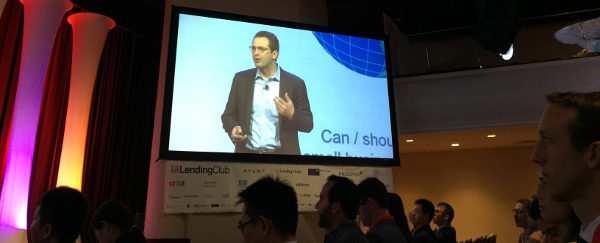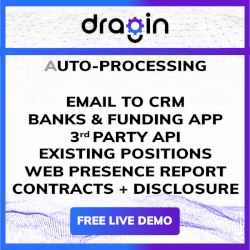Business Lending
The Top 8 Small Business Funders
March 13, 2016Whether they do loans or merchant cash advances, here are the top 8 alternative small business funders:

This list originally appeared in a story about Square’s Q4 Earnings and has been republished individually here in case anyone missed it. The figures were either disclosed to deBanked directly or are a best estimate based on publicly available materials. This list is not comprehensive and in instances where no reliable data could be obtained, the company was just omitted. A larger list will appear in deBanked’s March/April Magazine issue so make sure you subscribe if you haven’t already.
Bank Strikes Back Against Online Lenders – Offers 5 Minute Business Loans
March 12, 2016Online lenders have new competition, a 198-year-old bank based in Boston, Eastern Bank. Worried that technology would leave them in the dust, Eastern has invested millions in an application and underwriting system that can fund merchants up to $100,000 in 5 minutes. “The 55 requests for information on the old form have been replaced by eight,” according to the WSJ.
Rates range from 6.99% to 9.99% and it’s only available to existing customers. However a new customer only need open a checking account to become immediately eligible for it. One out of the 36 original borrowers on this program has already become delinquent on their loan, a statistic mostly within their expectations, the WSJ reports.
Eastern makes no mention of their speedy capabilities on their website, which still has the old paper application available for download.
Notably, former NFL player Doug Flutie, Eastern Bank’s spokesman for over 10 years, is scheduled to appear on the upcoming season of Dancing With the Stars.
Big Banks Less Transparent Than Online Lenders Federal Reserve Study Finds
March 4, 2016The results are in. Dissatisfied small business borrowers are more likely to encounter transparency problems with big banks, not online lenders.
The margin of difference on this measure may have been razor thin, but the anti-online lender rhetoric isn’t matching up with borrower feedback. The 2015 Small Business Credit Survey, a comprehensive report released by the Federal Reserve, found that 33% of borrowers that were dissatisfied with a small business loan from a big bank, cited a lack of transparency as a reason. 32% of borrowers that were dissatisfied with an online lender cited a lack transparency. While both statistics show room for improvement, the results shatter the myth that online lenders are uniquely lacking in transparency.

 The findings are also consistent with the results of a previous Federal Reserve study in which small business owners gave extremely high marks to online lenders for clarity (even after researchers tried to trick them). This latest report does not put online lenders in a favorable light, but it does show that a dissatisfied borrower is equally or more likely to be confused by a loan from Chase or Bank of America than they are from OnDeck or PayPal Working Capital.
The findings are also consistent with the results of a previous Federal Reserve study in which small business owners gave extremely high marks to online lenders for clarity (even after researchers tried to trick them). This latest report does not put online lenders in a favorable light, but it does show that a dissatisfied borrower is equally or more likely to be confused by a loan from Chase or Bank of America than they are from OnDeck or PayPal Working Capital.
Small banks were less likely than online lenders and big banks to experience dissatisfaction over transparency.
Online lenders were defined by the Fed as “alternative and marketplace lenders, including Lending Club, OnDeck, CAN Capital, and PayPal Working Capital.” Respondents could select multiple options for dissatisfaction, ensuring that a separate issue didn’t merely trump transparency.
Big banks also scored worse on difficulty of the application process. 51% of dissatisfied borrowers that got a loan from a big bank cited difficulty. Only 21% of dissatisfied borrowers that got a loan from an online lender cited difficulty.
A more difficult, lengthier, and more regulated process at big banks has apparently not led to more transparency with borrowers. The findings echo B. Doyle Mitchell Jr.’s testimony presented during a House Committee hearing last fall. Mitchell, who was speaking on behalf of the Independent Community Bankers of America, said that adding more pages to loan agreements do not make them any more clear to borrowers. “In fact it is even more cumbersome for them now,” he said.
The Federal Reserve’s own study has proven to be consistent with that assessment.
Here’s Why Small Businesses Like Small Banks
March 3, 2016Small businesses like small banks.
The Small Business Credit Survey released by the Federal Reserve revealed that small businesses like doing business with smaller banks mostly with rate of approval and customer satisfaction.
Small banks approved at least some of the amount requested for 76 percent of applicants, while large banks approved 58 percent of the applicants. And when it came to customer relations, small banks scored a satisfaction score (percent of firms satisfied with the experience) of 75 while the big banks earned a score of 51.
And while banks still dominate as an advisory and credit channel, the survey suggested that 30 percent of microbusiness applicants and 22 percent of small firms ($100K–$1M in annual revenues) applied to an online lender, presumably because these applicants consider online lenders to be as credible as the big banks and despite the lower interest rates, the loan difficulty process and the wait for approval has the small businesses seek alternatives to the traditional bank credit system.
Is Jamie Dimon in Favor of Stacking?
March 2, 2016In a featured interview with Bloomberg Markets, JPMorgan Chase CEO Jamie Dimon made a curious argument about small business lending. Speaking about tech-based lenders, Dimon paints the following picture:
For example, they might lend to one of our customers who’s got a $200,000 JPMorgan Chase loan, and this person wants to get another $20,000 for a new truck or a piece of equipment. And what does he do? He goes with them, because he gets it in 15 minutes. If he goes back to the bank, he may have to go through this whole big long process for that $20,000.
Can we do something like that? Of course we can. I’ve asked our people, “Why don’t we just put a revolver on top of our basic loan?” Make it easier for the client.
Whether intentional or not, Dimon’s example is the classic argument made in favor of stacking in the merchant cash advance industry and it’s entirely about doing right by the client. He also said there is nothing mystical about tech-based lenders. “They’re very good at reducing the pain points,” he said. “They can underwrite it quicker using—I’m just going to call it big data, for lack of a better term: ‘Why does it take two weeks? Why can’t you do it in 15 minutes?”’

OnDeck (ONDK) Stock Continues to Sink. Now What?
February 26, 2016OnDeck reached another new all-time low share price on Thursday, closing at $6.35 but hitting $6.05 intraday. The continued spanking follows their 2015 earnings release that apparently did not impress the market. And there’s many reasons to be troubled by that since the tone of the earnings call oozed of renewed confidence. It was expressed as much in OnDeck Regains Their Swagger in Q4 Earnings Call – Lends $1.9 Billion in 2015
OnDeck can’t win. When growth was high, critics complained about profitability. When OnDeck achieved profitability, critics complained that growth had slowed. On Wednesday, critics hit them with the kitchen sink. Growth has slowed, losses are mounting, guidance was revised down, the JPMorgan Chase partnership isn’t yielding revenue, operating expenses rose, etc.
The real problem now is that they can’t seem to overcome these objections during a period of economic calm. The stock market is currently operating at rather rational levels. The S&P 500 is only down 3% year-to-date. OnDeck is down 35% over that same time period.
In a recession, financial companies can be uniquely vulnerable to irrational fear. JPMorgan Chase for example, lost more than 50% of their market cap between August 2008 and February 2009. This is a nightmare scenario now for OnDeck.

“These companies have been valued as if there’s really no credit risk or capital-markets risk whatsoever,” said Bill Ryan, an analyst at Portales Partners, to the WSJ. “I think that’s what changed.”
“We are not seeing weakness in our portfolio at this time,” said OnDeck CEO Noah Breslow during the earnings call.
Apparently that doesn’t matter and one has to wonder what will in the future.
No, Social Media isn’t the New Credit Score
February 25, 2016 The “social media is the new FICO score” crowd suffered a blow on Wednesday when a Wall Street Journal article reported that it ain’t working too good.
The “social media is the new FICO score” crowd suffered a blow on Wednesday when a Wall Street Journal article reported that it ain’t working too good.
Almost 3 years ago, Kabbage co-founder Marc Gorlin told CNN that small businesses who link up their facebook and twitter accounts up with their system, were 20% less likely to be delinquent on their loans. Around that time, Hong Kong-based Lenddo was heralding other positive claims about the value of social media. In the loans they made in Colombia and the Philippines for example, Slate reported that “they scrutinized the applicants’ connections on Facebook and Twitter and that the key to getting a successful loan from Lenddo was having a handful of highly trusted individuals in your social networks.”
For a time, non-bank lenders were saying that social media was the future of credit. That is until it wasn’t.
The WSJ recently reported that lenders are backing away from social media data because it’s becoming harder to tap into and because of the potential regulatory consequences under fair credit laws. Just last month for example, the FTC published a report titled, Big Data, A Tool for Inclusion or Exclusion? In it, the FTC warned that “if a company targets services to consumers who communicate through an application or social media, they may be neglecting populations that are not as tech-savvy.” The implication is that there is potential for unconscious and unintended discrimination of certain minority groups. “Systemic disparate treatment occurs when an entity engages in a pattern or practice of differential treatment on a prohibited basis. In some cases, the unlawful differential treatment could be based on big data analytics.”
But even then, companies like Kabbage have seemingly softened their stance on the value of social media anyway. “Who your social circle is, or whether you play ‘Mafia Wars’—we haven’t seen that as very valuable,” Kabbage CEO Rob Frohwein said to the WSJ.
Facebook is restricting the depth of data available to third parties now anyway. As a result, dozens of startups (not just lenders) that had been using Facebook data have shut down, according to the WSJ.
Lenders like OnDeck might not be surprised by the industry’s sudden realization. Two years ago at LendIt 2014, company CEO Noah Breslow said you have to be careful with the noise of social media as there can be a lot of false signals. And RapidAdvance COO Joe Looney was already telling CNBC three years ago that his company was “not going to make a decision based solely on a string of online comments on a social-media site” even though they would consider the mere presence of an active social-media footprint to be a “good sign.”
It looks like the future of credit scoring isn’t likely to be social media any time soon. All hail the fundamentals.
Loan Brokers: Here’s How to Submit a Deal to a Licensed California Lender
February 24, 2016 Brokers that wish to submit deals to a licensed California lender must also be licensed in the state. This does not apply when the lender is lending via a chartered bank relationship or if the transaction itself is a purchase of future receivables (AKA a traditional merchant cash advance). QuarterSpot for example, recently became a licensed lender (#603-K646) and will be operational to lend in the state starting on March 7th, according to the company.
Brokers that wish to submit deals to a licensed California lender must also be licensed in the state. This does not apply when the lender is lending via a chartered bank relationship or if the transaction itself is a purchase of future receivables (AKA a traditional merchant cash advance). QuarterSpot for example, recently became a licensed lender (#603-K646) and will be operational to lend in the state starting on March 7th, according to the company.
While the process wasn’t easy, they want to make sure that brokers are abiding by the rules as well. To this end, QuarterSpot EVP Mike Green posted a link on the deBanked forum to the licensing form that brokers must complete to apply:
We will require our partners to submit their CFLL License as required by the State. Please send those in ASAP to partners@quarterspot.com
1. Licensing form outlining requirements for licensure – http://www.dbo.ca.gov/forms/Finance_Lenders/DBO_CFLL_1422.pdf
2. Article further explaining legislation – http://www.paulhastings.com/publications-items/details/?id=e867e669-2334-6428-811c-ff00004cbded
In addition to the 31 page application is the payment of a $25,000 Surety Bond. Suffice to say, the process and costs are probably not a good fit for a 2-man upstart loan brokerage with a razor thin budget working out of month-to-month office space. But for a moderately sized operation or bigger, being a licensed broker can potentially be a competitive advantage.
The reason that brokers don’t need to be licensed to send deals to lenders like OnDeck, is because OnDeck operates through a chartered bank relationship and is therefore exempt from licensing requirements. As always, ask an attorney for an opinion if you’re not sure or need help. A broker may be just as culpable for submitting a deal to an unlicensed lender as the lender would be for operating unlicensed.
You can check to see if a lender is licensed at http://www.dbo.ca.gov/fsd/licensees/ but keep in mind that the database is rarely updated (the last time was 2 months ago).
Other helpful information
Can California Lenders Pay Referral Fees to Unlicensed Brokers?
Getting a California Lender’s License






























